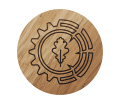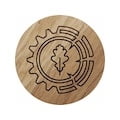MAINTENANCE INSTRUCTIONS FOR SOLID WOOD, STEEL AND COPPER FURNITURE
Maintenance, care and cleaning of wooden furniture – how to care for solid wood furniture?
Information on the rules of furniture storage:
Wood is natural raw material that expands and shrinks under the outflow of humidity and temperature, which is called ‘wood work’. Furniture must be used indoors and protected from harmful weather influences. Optimal conditions in room are humidity in range of 40-60% and temperatures between 15 and 30°C. Changes in humidity and high temperature changes can lead to changes in shape of wooden elements. Too dry air can lead to deformation of solid wooden parts. If the humidity is too low or high, there is risk that wood will break. It is recommended to use additional moisture in room in winter, when the humidity drops significantly.
Instruction for the maintenance and use of oak tables, basic rules:
- Should follow the rules for use wooden surfaces.
- Furniture should be cleaned systematically – do not allow furni-ture to be too dirty.
- For daily care, you should use gently moistened and soft cloth and try to wipe furniture to dry.
- Do not use for tearing off dust: sharp sponges, scrapers, prepa-rations with pellet, which could scratch the furniture surface.
- Do not use diluents, corrosive measures, stain removers or other means that may adversely affect lacquered surface
- Any dirt or wet stains should be removed immediately with dry cloth or special preparations for lacquered wood.
- Never apply the preparation directly to the furniture. In addition, do not leave cleaning and preservatives applied to the surface without spreading them, rubbing. Soak a soft microfiber or flannel cloth with it and only then clean the furniture with it.
- Wooden furniture should always be rubbed in direction of wooden rings.
- Keep a minimum 1m distance from heat sources, for example: fireplaces, heaters, stoves and stoves.
- Do not put hot, damp and very cold things directly on tabletop. Should use place blankets, even for writing.
- Rooms hould be ventilae and should avoid that tabletops are left in damp rooms.
- Protect furniture from water – wipe spilled water immediately dry.
- Avoid contact of furniture with wet surfaces: wet floors, carpets, shower cabin walls, since wood can absorb water.
Maintenance and use of copper countertops – instruction, basic rules
- Copper enters into chemical reactions with acid (for example: lemon).
- When discoloration occurs, over time, the discolored place overlaps with a natural patina.
- Watch out for products that can easily discolor the natural patina of copper: orange and lemon juice, ketchup, toothpaste, vinegar.
- When cleaning and using the copper table top, be careful of any caustic agents or aggressive substances, chlorine-containing products. As well as any means that can damage the surface in a mechanical way. Such agents are, for example, cleaning powders as well as agents containing abrasive or rinse aids. Their use can permanently damage the surface of the tabletop.
- To keep the surface of kitchen countertops clean, simply use a sponge moistened with warm water or one of the generally available detergents. Then clean the countertop with clear water and wipe it dry.
- Before using a detergent, read its description and make sure it is suitable for this type of surface.
- Do not place hot, damp or very cold objects directly on the surface of tabletop. Use suitable washers for this.
- Do not scrape the surface with sand or scrub the surface with wire brush.
Instructions for maintenance and use of powder-coated steel frame:
- Avoid placing the rack in place of external factors such as fire, water, salts, acids, organic solvents containing: esters, alcohols, flavors, glycolic ester or chlorinated hydrocarbon materials. Also other aggressive chemicals such as cement, lime, abrasives or cleaning agents that cause material losses or scratches.
- Do not place the rack in a wet, damp place, exposed to water, as this may cause corrosion of elements.
- Do not use for washing scouring powders, as they may leave scratches on the surface.
- Serious oil or grease stains may be removed by alcohol-based products including methyl spirit and isopropyl alcohol, or by other solvents such as acetone. These agents do not pose a danger to the anti-corrosion properties of the coating.
- Cleaning tools – wet fabric or suede leather will usually be sufficient to remove ordinary dirt. For more resistant dirt, nylon sponges are usually suitable. Do not use scrub pads, cleaning wool or wire brushes on powder-coated steel.
- Maintenance of powder-coated steel: the surface must be periodically washed using clean tap water with a small addition of kitchen detergents.
RaWood is not responsible for natural wear of material resulting from exploitation, natural aging of wood, mechanical, chemical, painting or structural damage caused as a result of improper care, lack of care or care inconsistent with the rules of furniture care, discoloration of fronts exposed to prolonged sunlight, improper maintenance, chemicals, impacts, fire, increased effects temperatures, use of force, exposure to inappropriate weather conditions, repairs or alterations performed by the Buyer or use of the Subject of the Agreement inconsistent with the principles of proper use of furniture.

